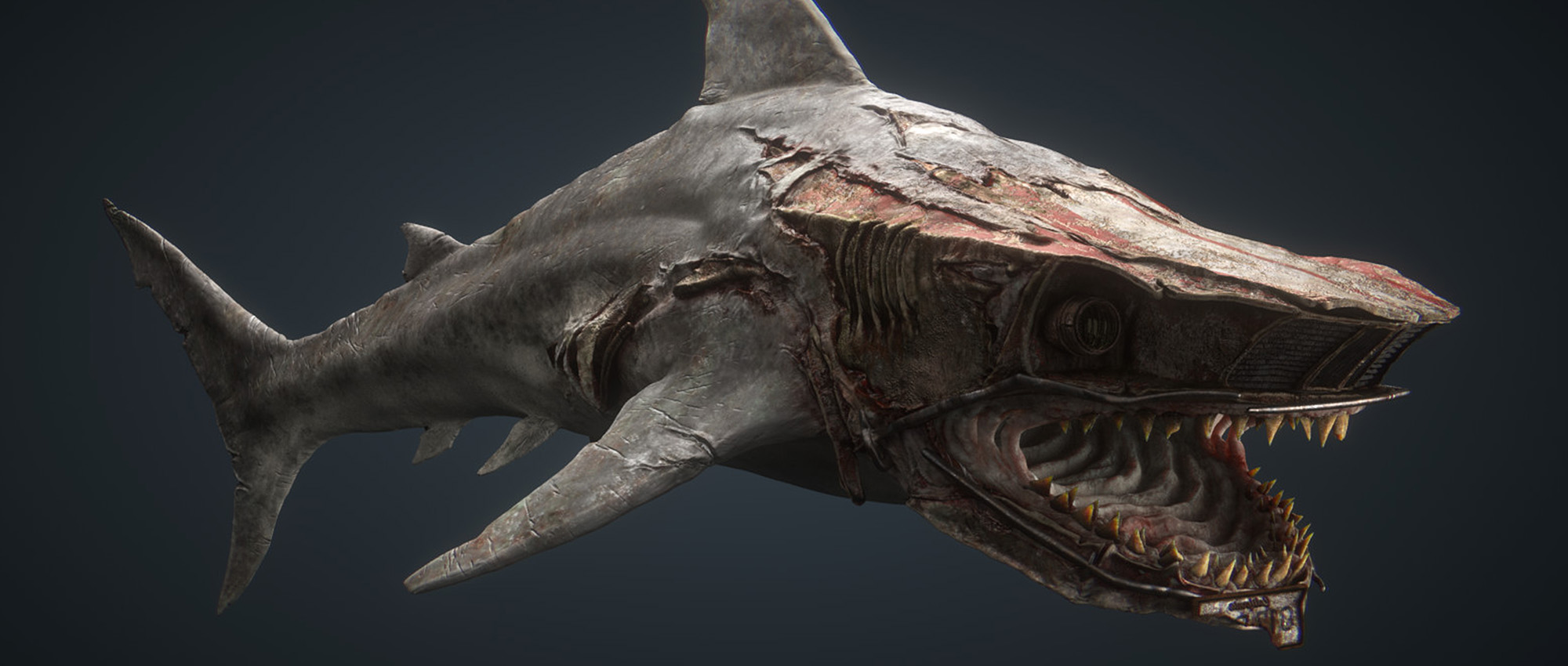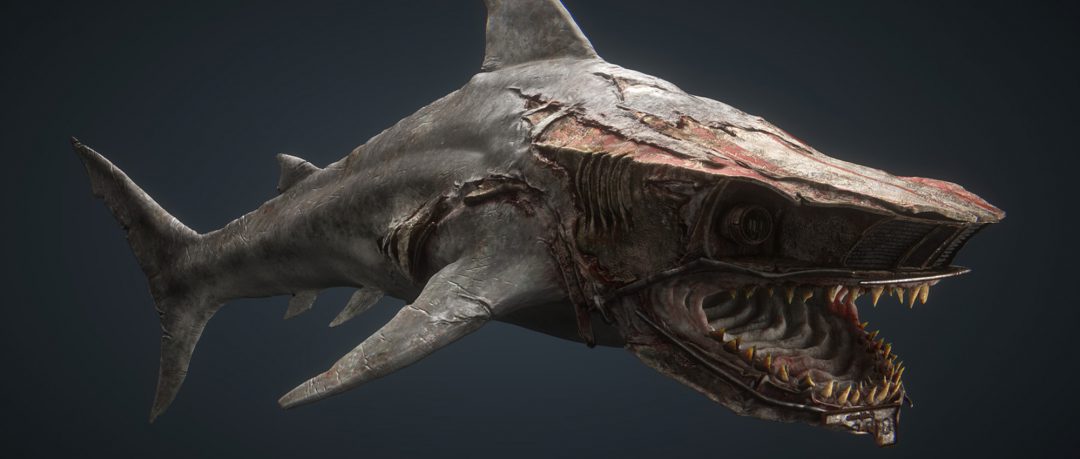 Hybrids: A Top-Grade Student Short Film Made With Substance
Hybrids: A Top-Grade Student Short Film Made With Substance
In this interview, we talk with a team of students from Motion Picture in Arles (MOPA), a computer graphics school focusing on 3D animation. The team worked on an impressive graduation movie, HYBRIDS, which is yet to be released. They talk about their texturing workflow on the project with Substance Painter.
Hi guys, thanks a lot for taking your time for this interview. Could you introduce yourselves to the community?
We are five students who recently graduated from MOPA, a 3D animation school, and we are super excited to present our graduation film HYBRIDS.
Romain Thirion – I was in charge of the design, modeling, texturing and shading of most of the characters in the film. I also did all the compositing.
Matthieu Pujol – I was in charge of creating the crab army, also did all the FX and worked on the various environments with Kim and Romain.
Kim Tailhades – I was in charge of creating the Squid, most of the set dressing of the environment and the lighting.
Florian Brauch – I was in charge of a part of the animation. I also did crabs and LED rigs and a lot of previsualization.
Yohan Thireau – I was in charge of a part of the animation, most of the rigs and the crowd simulation for the crabs.
We are five students who recently graduated from MOPA, a 3D animation school, and we are super excited to present our graduation film HYBRIDS.
Romain Thirion – I was in charge of the design, modeling, texturing and shading of most of the characters in the film. I also did all the compositing.
Matthieu Pujol – I was in charge of creating the crab army, also did all the FX and worked on the various environments with Kim and Romain.
Kim Tailhades – I was in charge of creating the Squid, most of the set dressing of the environment and the lighting.
Florian Brauch – I was in charge of a part of the animation. I also did crabs and LED rigs and a lot of previsualization.
Yohan Thireau – I was in charge of a part of the animation, most of the rigs and the crowd simulation for the crabs.
Could you tell us more about your school and your graduation movie?
RT – During the last year of our five-year program, we had the chance to work exclusively on a short film, about 6 minutes long in full CG. We were five people in charge of everything, from directing to CG and sound design. Only the music was made externally.
FB – The original idea was found during our 4th year at school, and we developed the idea at this point. The production itself began in September 2016 and ended in June 2017.
What was the idea behind its creation? Where did you find your inspiration?
RT – The idea came from diving and finding rubbish in the ocean, and thinking how nature could use the pollution to enhance its defenses.
RT – During the last year of our five-year program, we had the chance to work exclusively on a short film, about 6 minutes long in full CG. We were five people in charge of everything, from directing to CG and sound design. Only the music was made externally.
FB – The original idea was found during our 4th year at school, and we developed the idea at this point. The production itself began in September 2016 and ended in June 2017.
What was the idea behind its creation? Where did you find your inspiration?
RT – The idea came from diving and finding rubbish in the ocean, and thinking how nature could use the pollution to enhance its defenses.
Tell us more about your workflow on this project.
RT – The first big challenge was to define the right characters and find the right animals to create archetypal characters. We then found the ideas for different sequences involving those creatures.
For the technical pipeline, we did most of the models in ZBrush and Maya, textured them in Substance Painter, and did the render in Arnold in Maya. We also used Golaem for the crowd, Houdini for the FX and Nuke for the compositing.
When did you discover Substance Painter? How long did it take you to correctly master the tool?
RT – We really discovered Substance Painter at the beginning of the year, and it took us about two or three weeks to master all the different functions.
RT – The first big challenge was to define the right characters and find the right animals to create archetypal characters. We then found the ideas for different sequences involving those creatures.
For the technical pipeline, we did most of the models in ZBrush and Maya, textured them in Substance Painter, and did the render in Arnold in Maya. We also used Golaem for the crowd, Houdini for the FX and Nuke for the compositing.
When did you discover Substance Painter? How long did it take you to correctly master the tool?
RT – We really discovered Substance Painter at the beginning of the year, and it took us about two or three weeks to master all the different functions.
How did it enhance your texturing workflow on this project?
RT – Our texturing workflow was really enhanced by the fact that we could reuse our own presets of textures such as rusty metal, underwater rocks, and fish skin. As we were working on photorealistic textures, Substance Painter was really an accurate tool.
MP – A huge advantage of Substance Painter, as Romain said, was the reusability of our presets. For the crab army I had to find the right feel for one crab and then I had the ability to very quickly randomize it to get the entire army, shifting some masks and colors.
KT – The creation of the squid was different from the other characters. Since it was very large, I had to work with different UDIMs for the organic part of the head. For this part, it was mainly textures generated for the base and a lot of painting.
For the metal parts of the whole plane I worked each item separately. The materials I found on Substance Share helped me a lot.
RT – Our texturing workflow was really enhanced by the fact that we could reuse our own presets of textures such as rusty metal, underwater rocks, and fish skin. As we were working on photorealistic textures, Substance Painter was really an accurate tool.
MP – A huge advantage of Substance Painter, as Romain said, was the reusability of our presets. For the crab army I had to find the right feel for one crab and then I had the ability to very quickly randomize it to get the entire army, shifting some masks and colors.
KT – The creation of the squid was different from the other characters. Since it was very large, I had to work with different UDIMs for the organic part of the head. For this part, it was mainly textures generated for the base and a lot of painting.
For the metal parts of the whole plane I worked each item separately. The materials I found on Substance Share helped me a lot.
On which assets did you use Substance Painter?
RT – We used Substance Painter on all the assets of the film. For the environments we had a very fast texturing workflow, where only one homemade texture preset was used for the rocks, bringing in some random variations for it to look natural. For the characters, Substance Painter really helped us to blend the metal and the skin with small procedural scares, impacts, and wrinkles.
Could you show your texturing workflow on one particular asset?
RT – We used Substance Painter on all the assets of the film. For the environments we had a very fast texturing workflow, where only one homemade texture preset was used for the rocks, bringing in some random variations for it to look natural. For the characters, Substance Painter really helped us to blend the metal and the skin with small procedural scares, impacts, and wrinkles.
Could you show your texturing workflow on one particular asset?
What is your favorite feature in Substance? Which ones would you like to see in the future?
RT – The smart masks are so powerful. Combining them is like doing compositing in texture. In the future we would love to see multi-tile handling and refractions. SSS in the IPR would be great.
MP – As Romain said, the smart masks are a really fast way to get great results. A better bridge between Arnold Alshaders and Substance Painter would be awesome; multi-tiling as well.
KT – After working with different UDIM and SSS I have to say that I agree with Romain.
RT – The smart masks are so powerful. Combining them is like doing compositing in texture. In the future we would love to see multi-tile handling and refractions. SSS in the IPR would be great.
MP – As Romain said, the smart masks are a really fast way to get great results. A better bridge between Arnold Alshaders and Substance Painter would be awesome; multi-tiling as well.
KT – After working with different UDIM and SSS I have to say that I agree with Romain.
What are your projects for next year?
RT – Work as a character/creature build TD while enhancing my character design skills.
MP – I’ll focus mainly on FXs but a tool such as Substance Painter allows me to create more complete projects without having to spend too much time on texturing.
KT – I love the lighting but I’m a little bit more generalist. Even if I see myself later as a lighting artist, I would be happy to work as an environment artist too and continue to use Substance Painter!
Lastly, could you send us a picture of yourselves?
RT – Work as a character/creature build TD while enhancing my character design skills.
MP – I’ll focus mainly on FXs but a tool such as Substance Painter allows me to create more complete projects without having to spend too much time on texturing.
KT – I love the lighting but I’m a little bit more generalist. Even if I see myself later as a lighting artist, I would be happy to work as an environment artist too and continue to use Substance Painter!
Lastly, could you send us a picture of yourselves?
















